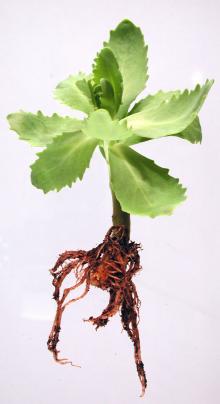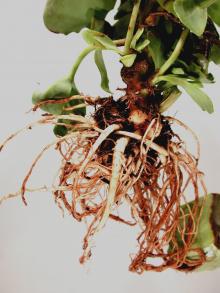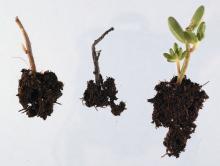See:
Greenhouse Plants, Ornamental - Pythium Seed Rot, Damping-off, and Root Rot
Cause Pythium sp. and Phytophthora sp. have been found several times by the OSU Plant Clinic. These pathogens are favored by water saturated soil conditions from over watering and/or poor drainage. Other pathogens may invade injured tissues or plants growing in poor conditions. Fusarium sp. has also been found as a root and crown rot of Sedum.
Symptoms Plants can appear stunted or chlorotic, and may wilt even when enough water is available for growth. Diseased roots are discolored brown and/or appear water soaked. Rots may extend up into the stem. Fine roots turn mushy and slough off leaving mostly thicker, older roots behind. The root cortex of the smaller roots can often be easily slipped off, thus leaving a white cylinder of vascular tissue behind.
Cultural control
- Grow in full sun on well-drained soil or media at neutral to slightly alkaline pH.
- Good drainage and water management are essential components of a management plan. Ensure growing media and holding areas are well drained.
- Do not over-fertilize.
- Rooted plants acquired from other nurseries should be inspected and placed in a quarantine area where they can be held and monitored for disease development for a few weeks.
- Use new pots, trays, or treat any reused items with a disinfectant, use steam, or solarization techniques (such as with anti-condensation film) to clean them.
- Growing media could be treated by steam (140°F for 30 minutes), solarization (double-tent at 160°F for 30 minutes or 140°F for 1 hour), or chemically. Storage area surfaces should be easy to clean and disinfest. This could include metal or plastic bins, trailers, trolleys, in bags on a sealed surface, or racks under cover.
- Use ground sources for irrigation and avoid surface water sources for propagation of the crop.
- Remove crop residue and old or low-quality plants that will not be marketed as they can become sources of inoculum.
Chemical control Fungicides are best used as protectants in combination with cultural controls. Once symptoms are observed, the disease is difficult to control. Therefore, prevention is key. Rotate among fungicides with different modes of action to help prevent fungicide resistance from developing. Not many fungicides have this host on the label but others may legally be used. Test first on a small section before applying on the whole plant to evaluate possible phytotoxicity.
- Fosphite at 1 to 2 quarts/100 gal water. Do not use copper products within 20 days of treatment and do not use spray adjuvants. Group P7 fungicide. 4-hr reentry.
Reference Moorman, G.W., Kang, S., Geiser, D.M., and Kim, S.H. 2002. Identification and characterization of Pythium species associated with greenhouse floral crops in Pennsylvania. Plant Disease 86:1227-1231.




